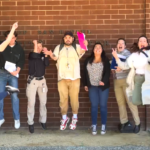Part Two of a two-part report. Read Part One here.
Last week, San Rafael capitulated to residents complaining about homeless encampments by passing an ordinance that severely curtails camping. The new rules don’t come close to resolving the issues raised by people who say they are upset about crime, fires, trash and human waste at the camps.
Instead, the ordinance will exacerbate San Rafael’s homelessness crisis by forcing many people to exit established encampments and pitch their tents in nooks and crannies throughout the city, including residential neighborhoods.
The objectives of the regulations, which go into effect on Aug. 16, are to reduce the number of people living in existing camps and to prevent new “high concentration encampments.” This is accomplished through limiting each campsite to a small footprint. In addition, there must be at least 200 feet of separation between campsites.
Officials maintain that larger camps lead to increased public health and safety issues.
Let’s assume for a moment that it’s critical to reduce the size of encampments in San Rafael, particularly the largest one on the Mahon Path. The city has indicated that more than half of the approximately 40 homeless people living there must relocate to comply with the ordinance. And in a strange twist, officials say the campers will need to decide amongst themselves who stays and who goes.
I visited the Mahon Path twice recently and spoke with many of the homeless campers. None of them want to volunteer to leave. And, if they’re one of the unlucky ones pushed out by their peers, they don’t know where to go.
City officials steadfastly refuse to identify places for the ousted folks to live.
“We’re relying on our partners for that,” Chris Hess, San Rafael’s assistant director of community development, housing and homelessness, told me during an interview.
Those partners are several nonprofit organizations, including Homeward Bound, Downtown Streets Team, Community Action Marin, St. Vincent de Paul Society of Marin and the Ritter Center, that work with homeless people throughout the county by helping them obtain services and shelter. The ultimate goal is for case managers to stay connected with their homeless clients and keep them on a path toward permanent housing.
But the partners aren’t magicians, and it’s almost certain that few, if any, of San Rafael’s displaced homeless people will receive a shelter bed or housing before the ordinance requires them to move to places unknown.
The supply of shelter beds in Marin is woefully inadequate, with less than 200 shelters beds for an estimated 1,121 homeless people, according to last year’s federally mandated point-in-time count.
One organization, Homeward Bound, operates most of the shelters in the county. While the majority of its beds are for adults coming in from the street, other beds are allocated specifically for homeless families, homeless folks just released from the hospital and homeless people with mental health issues. Another nonprofit provides shelter for people impacted by domestic violence.
Homeward Bound remains perpetually at capacity, although a minimal number of beds typically turn over on a weekly basis. Last Thursday, I called Paul Fordham, Homeward Bound’s co-chief executive officer, to ask how many beds were available for individuals living on the street.
“Today, right now, the answer is absolutely none,” Fordham said. “We are 100% full in our shelters at this moment. All 38 beds at Jonathan’s Place and all 80 at New Beginnings are full.”
It doesn’t appear that the situation will improve anytime soon. Fordham says about seven of every 10 people who leave Homeward Bound move into permanent housing. Currently, no Section 8 housing vouchers are available, and a new allocation isn’t expected until late fall.
“People are not moving through the shelter and out into housing anywhere near as fast as they were 12 months ago,” Fordham said. “We definitely have more demand than we have openings.”
Without enough shelter beds, the homeless people displaced by San Rafael’s new camping restrictions will scatter. Some may remain nearby. Others may move to remote areas, such as up in the hills.
The result is that case managers often won’t be able to locate the clients they’ve been tasked with helping.
“We’re doing our best, but as people get spread out everywhere it’s going to become a lot harder,” Zoë Neil, director of Downtown Streets Team, said in an interview. “We’ll have outreach coordination meetings with other service providers to say, ‘I can’t find Joe and we have a housing appointment set. Can you guys please let me know if you see him?’”
And if a case manager loses contact with a client for 90 days, the homeless person is dropped from case management. Unfortunately, there simply aren’t enough case managers in the county for everybody who needs one.
San Rafael’s ordinance seems extremely short-sighted. To appease complaining residents, the city is compromising the long and complicated process of getting people off the streets and into a shelter or permanent home.
The city’s partners can’t move mountains, Neil says. When I spoke with leaders at most of Marin’s other nonprofit groups working with homeless people, they voiced similar concerns.
“There’s not a lot we can do, of course, when there are incredible limitations on the number of shelter spaces and housing units available for folks,” said Chandra Alexandre, chief executive officer of Community Action Marin. “If people need medical assistance or any kind of immediate support, we’re there to help provide that for them. Clothing, blankets, tents, socks, hygiene kits, emergency food.”
I pressed Hess, San Rafael’s assistant director of homelessness, about his repeated assurance that the city’s partners would help the campers displaced by the ordinance. He failed to provide further details.
City Councilmember Rachel Kertz, who was also present when I interviewed Hess, took a stab at elaborating on the role the nonprofit partners would play.
“We can’t answer specifically, but partnerships are so integral to the city,” Kertz said. “As we go through the process, we’ll rely on them for the next step—maybe it’s just helping a homeless person around the corner. The plan is to make sure people know they’re held and supported, even if we’re not saying, ‘Here’s where you go next.’”
Somehow, hand-holding doesn’t seem like enough when a homeless person is required to move from the place they’re living and separate from their community.
San Rafael officials are well aware that a viable temporary solution exists—a city-sanctioned homeless encampment. In fact, for over a year, the city ran a “service support area (SSA).” It closed permanently in August 2022.
While critics were unhappy with its location beneath a busy freeway overpass, the city provided security, porta potties, handwashing stations and trash pickup. Equally important, case managers knew where to find their homeless clients and were successful in connecting them with services and housing.
“The city is not considering a sanctioned encampment along the Mahon Path or elsewhere,” Hess said. “We did that with the SSA and we’re proud that 35 of the 47 people ended up housed.”
The sanctioned camp was an expensive undertaking. I guess it’s not surprising that San Rafael won’t pony up to keep the Mahon Path encampment safe and sanitary, since officials won’t even pay for the two porta potties and handwashing station that are currently on site. The homeless campers pay for those essentials, courtesy of donations from a GoFundMe page.
San Rafael has apparently abandoned the sanctioned encampment concept. Fortunately, the city is still employing their best ally in helping homeless people connect to housing—Lynn Murphy.
Murphy, who works for the San Rafael Police Department as the mental health outreach liaison, visits the city’s encampments daily.
“My focus is strictly on people who are homeless,” Murphy told me as I tagged along with her on an outreach mission that included about a dozen people from many of the city’s nonprofit partners.
They came together for a morning meeting and then fanned out across San Rafael to areas where homeless people are known to camp. The enthusiastic group, armed with pens and clipboards, wanted to contact as many of San Rafael’s homeless people as possible.
Their goal was to ensure that homeless folks had up-to-date information in the county’s coordinated entry system, the first step in eligibility for services and housing. If someone wasn’t in the system, case managers could assess them on the spot and input their data.
Watching Murphy and the case managers in action was impressive. Murphy knew the name of every homeless person we encountered, and they all had a smile for her.
The team spoke to more than 15 campers on the Mahon Path during my time with them. Every homeless person was in the system but one. Although the woman declined to be assessed, Murphy said they’ll continue to work at establishing a rapport with her.
Without a doubt, Murphy and the nonprofits are doing indispensable work. Still, odds are that none of the homeless people contacted will have a shelter bed or housing before San Rafael’s ordinance kicks in. Being in the system likely won’t help them in the short-term.
“We care very much about everyone living outside, but this is one of the trickier situations,” Neil, of Downtown Streets Team, said about the ordinance. “The time frame is not ideal at all. I don’t know what the city council expects us to do or what their constituents think is going to happen.”


